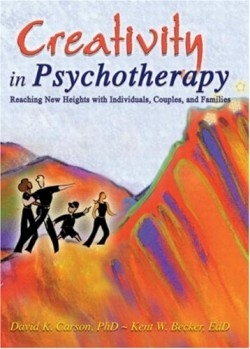Creativity in Psychotherapy
Reaching New Heights with Individuals Couples and Families
Therapy and creativity go hand-in-hand. But this excellent book may cause consternation for those in the mental health field who want psychotherapy to be standardized and predictable-think of managed care! Creativity represents the opposite of standardization. Can it even be taught and learned?
These authors say yes, convincingly. “In our view, therapeutic approaches that promote mental health often parallel methods which enhance creativity, with similar desired outcomes or ‘products.’” The authors, both psychologists in Wyoming with extensive backgrounds in marriage and family therapy, know the literature of creativity and of psychotherapy, as shown in a very rich bibliography, and in excellent summaries of ten contemporary modes of therapy. By enlisting 142 therapists from around the country to answer their questionnaires, they go beyond their own reading and experience, reporting hundreds of examples of applied creativity-an “everyday” approach that combines focus, imagination, humor, respect, risk-taking, self-assurance, and other qualities that can be enhanced in most people.
The authors explain convergent and divergent thinking, the “flow” experience, the role of habit and preparation, and the importance and limitations of technique. Creative language uses metaphors, which have an important place in talk therapy. An excellent topical metaphor here is improvisation, analogous to what jazz musicians do. This involves a degree of unpredictability introduced on a firm foundation of technique, an agreed-upon theme, where freedom flourishes within certain rules of performance. Indispensable for the creative therapist are intuition, awareness of one’s own positive and negative emotion and biases, tolerance for uncertainty and imperfection, and a desire to find pathways to new, helpful, fulfilling experience with individuals, couples, and families.
If these ideas sound relevant to other areas-teaching, parenting, medicine, business, sports-it is because they are. So this book deserves a broader audience than mental health professionals. Good therapists, like teachers and many others, help people find novel solutions to real problems. Carson and Becker, true to their theme, have a chapter on “The Importance of Creativity in Supervision,” where they stress the teachability of the new and different. They come across as experts in the consulting room who also know how to do research and impart their knowledge and skills to others. Not least of all, they write well, too!
Reviewed by
E. James Lieberman
Disclosure: This article is not an endorsement, but a review. The publisher of this book provided free copies of the book to have their book reviewed by a professional reviewer. No fee was paid by the publisher for this review. Foreword Reviews only recommends books that we love. Foreword Magazine, Inc. is disclosing this in accordance with the Federal Trade Commission’s 16 CFR, Part 255.

